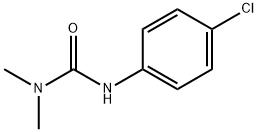Definition
ChEBI: A member of the class of ureas that is urea in which one of the nitrogens is substituted by a p-chlorophenyl group while the other is substituted by two methyl groups.
General Description
White crystalline solid or white powder with a slight odor. Melting point 175°C. Moderately toxic by ingestion. Used as an herbicide.
Air & Water Reactions
Insoluble in water. Is hydrolyzed slowly by acids and alkalis, and more rapidly on heating .
Reactivity Profile
MONURON is a chlorinated urea derivative. May react with azo and diazo compounds to generate toxic gases. May react with strong reducing agents to generate flammable gases. Reacts as a weak base. Combustion generates mixed oxides of nitrogen (NOx).
Fire Hazard
Flash point data for MONURON are not available; however, MONURON is probably combustible.
Hazard
Questionable carcinogen.
Chemical Properties
White, crystalline solid; odorless. Very low solubility in water and hydrocarbonsolvents; slightly soluble in oils; partially soluble inalcohols; stable toward oxidation and moisture.
Health Hazard
Toxic properties are similar to Diuron; hydro-lyzes under acidic or alkaline conditions top-chloroaniline, which can cause anemia andmethemoglobinemia; LD50 data published inthe literature differ; acute and chronic tox-icity of this herbicide is probably of loworder; no reported case of human poisoning; showed clear evidence of carcinogenicity in male F344/N rats fed diets containing 750 ppm monuron for 2 years; causedcancers in the kidney and liver (NationalToxicology Program 1988); female rats andmale and female mice (B6C3F1) showed noevidence; induced cytomegaly of the renalepithelial cells in rats.
LD50 oral (rat): 3700 mg/kg (Bailey andWhite, 1965)
LD50 oral (rat): 1053 mg/kg (Lewis 1995).
Flammability and Explosibility
Notclassified
Environmental Fate
Biological. Monuron was mineralized in sewage samples obtained from a water treatment
plant in Ithica, NY. (4-Chlorophenyl)urea and 4-chloroaniline were tentatively identified
as metabolites (Wang et al., 1985).
Soil/Plant. In soils and plants, monuron is demethylated at the terminal nitrogen atom
coupled with ring hydroxylation forming 3-(2-hydroxy-4-chlorophenyl)urea and 3-(3-
hydroxy-4-chlorophenyl)urea (Hartley and Kidd, 1987). Walln?efer et al. (197
Photolytic. When an aqueous solution of monuron was exposed to sunlight or simulated
sunlight, the major degradative pathways observed were the photooxidation and demethylation
of the N-methyl groups (Crosby and Tang, 1969; Tanaka et al., 1982a),
Tanaka et al. (1981) studied the photolysis of monuron in dilute aqueous solutions in
order to fully characterize a substituted diphenylamine that was observed in an earlier
investigation (Tanaka et al., 1977). They identified this compound as an isomeric mixture
containing 92% 2-chloro-4¢,5-bis(N¢,N¢-dimethylureido)biphenyl and 8% 5-chloro-2,4¢-
bis(N¢,N¢-dimethylureido)biphenyl (Tanaka et al., 1981).
Tanaka et al. (1982) undertook a study to identify the several biphenyls formed in
earlier photolysis studies (Tanaka et al., 1979, 1981). They identified these compounds as
2,4¢-, 3,4¢- and 4,4¢-bis-(N¢,N¢-dimethylureido)biphenyls (fenuron biphenyls) (Ta
Purification Methods
Crystallise monuron from MeOH. [Beilstein 12 IV 1191.]
